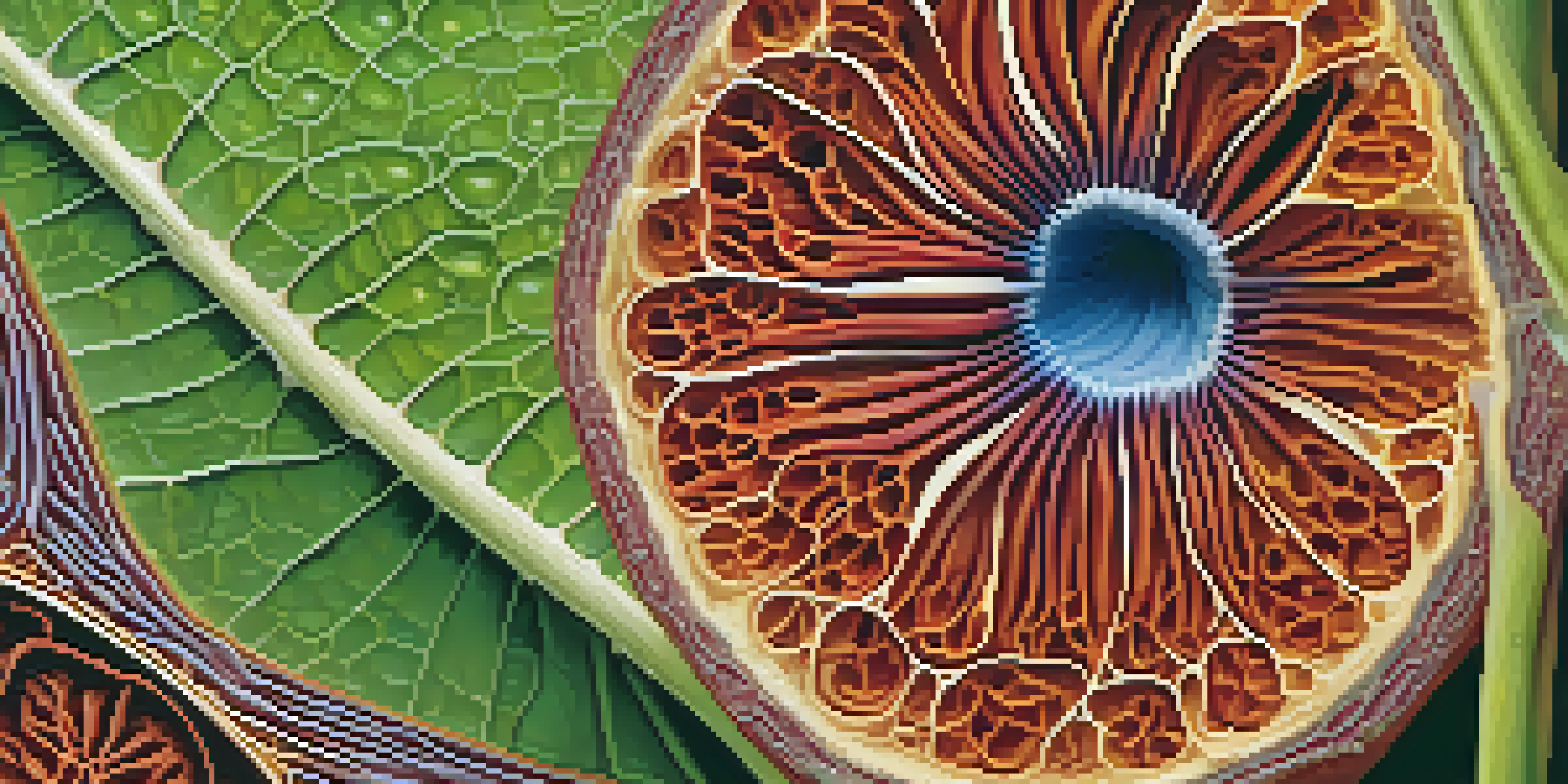Stems: Functions and Types in Plant Morphological Studies

What Are Stems and Their Importance in Plants?
Stems are vital structures in plants that serve as the main axis, connecting the roots to the leaves and flowers. They provide support, allowing plants to grow tall and capture more sunlight, which is crucial for photosynthesis. Additionally, stems transport water, nutrients, and food between the roots and leaves, ensuring that the plant functions efficiently.
Plants are the earth's endless effort to speak to the listening heaven.
Beyond their structural role, stems also play a part in reproduction. In many plants, stems can develop flowers and fruits, facilitating the process of pollination and seed dispersal. This versatility in function highlights the importance of stems in a plant's lifecycle, influencing growth and reproduction.
Moreover, stems can vary significantly in form and function across different species. Understanding these variations provides insights into how plants adapt to their environments and ecological niches. By studying stems, researchers can learn more about plant evolution and resilience.
The Different Types of Stems in Plants
Stems can be broadly classified into two main types: herbaceous and woody. Herbaceous stems are typically soft and green, found in plants like sunflowers and peas. These stems are flexible, allowing the plant to withstand wind and other environmental stressors, but they usually die back at the end of the growing season.

On the other hand, woody stems are thick, hard, and persistent, as seen in trees and shrubs. They provide greater structural support and longevity, allowing these plants to grow taller and survive in various climates. The woodiness comes from the accumulation of secondary growth, which strengthens the stem over time.
Stems Support Plant Growth
Stems provide essential support for plants, allowing them to grow taller and access sunlight necessary for photosynthesis.
Additionally, there are specialized stem types, such as rhizomes, tubers, and stolons. Rhizomes are underground stems that store nutrients, while tubers, like potatoes, are swollen structures that store energy. Stolons, or runners, spread horizontally above ground, allowing plants like strawberries to propagate easily.
The Structure of Stems: Anatomy Explained
Understanding stem anatomy is key to grasping their functions. A typical stem consists of three main regions: the epidermis, cortex, and vascular tissue. The epidermis serves as a protective outer layer, while the cortex stores nutrients and provides support. This structure ensures that the stem can withstand various environmental challenges.
The greatest threat to our planet is the belief that someone else will save it.
Within the vascular tissue, there are two types: xylem and phloem. Xylem is responsible for transporting water and minerals from the roots to the leaves, while phloem carries sugars produced through photosynthesis down to the roots or other parts of the plant. This dual system allows for efficient nutrient flow and overall plant health.
Moreover, the arrangement of these tissues can vary based on the type of stem. For instance, in herbaceous plants, vascular bundles might be scattered, whereas in woody plants, they are organized in a ring. This distinction affects how the plant grows and adapts to its environment.
Functions of Stems in Plant Growth and Support
One of the primary functions of stems is to provide support, which is crucial for upright growth. This support enables plants to reach for sunlight, which is essential for photosynthesis. Without sturdy stems, plants wouldn't be able to grow as tall or spread their leaves effectively, limiting their access to light.
In addition to support, stems also play a role in storage. Many plants store carbohydrates and other nutrients in their stems, which can be vital during periods of dormancy or drought. This storage capability ensures that the plant can survive adverse conditions and maintain growth when resources are scarce.
Diverse Stem Types and Functions
Plants exhibit a variety of stem types, such as herbaceous and woody, each serving distinct functions that aid in survival and reproduction.
Stems also aid in the plant's ability to reproduce. Through various adaptations, stems can produce flowers, fruits, and seeds, which are essential for propagation. This reproductive function demonstrates how stems contribute not just to individual plant health, but also to the continuation of species.
Adaptations of Stems in Different Environments
Plants have evolved various stem adaptations to thrive in diverse environments. For instance, cacti have thick, fleshy stems that store water, allowing them to survive in arid conditions. These adaptations are crucial for their survival, enabling them to withstand long periods without rainfall.
In contrast, climbing plants like vines have flexible, elongated stems that allow them to reach light by growing upwards. They often utilize other structures for support, showcasing their adaptability in competitive environments where light is a precious resource. This ability to climb demonstrates how stems can evolve to meet specific ecological challenges.
Additionally, some plants have developed specialized stems like thorns or spines for protection against herbivores. These adaptations not only deter predators but also play a role in the plant's overall survival strategy. Understanding these adaptations helps us appreciate the intricate relationships between plants and their environments.
The Role of Stems in Agricultural Practices
In agriculture, the understanding of stem types and functions can greatly influence crop production. For example, farmers often select plant varieties with strong, sturdy stems that can support heavy fruit loads. This selection process is crucial for maximizing yield and ensuring the stability of crops during adverse weather conditions.
Moreover, the study of stems can aid in the development of disease-resistant varieties. By examining the structural characteristics of stems, researchers can identify traits that help plants resist diseases. This knowledge can lead to the cultivation of healthier crops, ultimately benefiting food security.
Stems in Agriculture
Understanding stem characteristics is crucial in agriculture for selecting robust crops and developing disease-resistant plant varieties.
Additionally, stem modifications, such as grafting, are common practices in agriculture. Grafting involves joining the stem of one plant to the rootstock of another, combining desirable traits from both. This technique not only improves plant resilience but also enhances productivity, showcasing the integral role of stems in modern farming.
Future Research Directions in Stem Morphology
As our understanding of plant biology evolves, so does the research surrounding stem morphology. Scientists are increasingly focusing on the genetic and molecular mechanisms that dictate stem development and adaptation. This research could reveal new insights into how plants respond to environmental stresses and their overall growth patterns.
Moreover, advancements in technology, such as imaging techniques and genetic editing, are providing new tools for studying stems. These technologies allow researchers to visualize stem structures in greater detail and manipulate genes to enhance desirable traits. Such innovations could lead to breakthroughs in plant breeding and agricultural practices.

Finally, the exploration of stem morphology in relation to climate change is becoming increasingly important. Understanding how different types of stems respond to changing environmental conditions can inform conservation efforts and agricultural strategies. This focus on future research will help ensure that plants can adapt and thrive in a rapidly changing world.